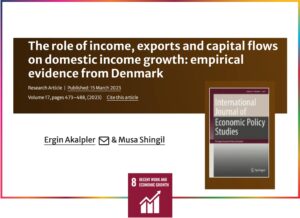
A study, featuring a researcher from Near East University as a co-author, examines the long-term growth trajectory of the Danish economy from 1980 to 2017. Focusing on the balance of payments constrained growth model, the research examines various factors influencing economic robustness and legitimacy.
The study identifies critical determinants of Denmark’s growth, including relative prices, exchange rates, and capital flows. Utilizing the Autoregressive Distributed Lag (ARDL) methodology, the research explores both short- and long-run relationships among these variables. The findings demonstrate that all considered variables significantly impact both short-term and long-term growth in Denmark.
Notably, the study supports the notion that income, relative prices, and capital flows play pivotal roles in driving the Danish economy’s demand side. The estimated annual real growth rate of 1.75% aligns with the growth rate observed in Denmark from 1980 to 2017, affirming the accuracy of the growth model.
From the demand side perspective, the research underscores the importance of export demand, capital movements, and relative prices. The balance of payment conditions emerges as a major constraint on the growth process, acting as a frontier to which supply can adapt.
Implications of the study include the significance of export growth in triggering a superior rate of real GDP growth by providing necessary foreign exchange earnings for financing import demands. However, capital outflow could increase constraints imposed by the balance of payments on long-term growth. Price competitiveness is identified as a factor enhancing domestic income growth by boosting exports and reducing import demands.
The study recommends a focus on external-oriented growth path development to achieve the forecasted 1.8% growth in 2019. Emphasizing the removal of constraints in the service sector, making interest rates attractive to connect with the global financial marketplace, and addressing institutional barriers are highlighted as crucial policy actions.
In conclusion, the research suggests that Danish monetary authorities should maintain a stable exchange rate against foreign currencies to ensure stable and low domestic prices. By contributing valuable insights to economic growth determinants, this study aligns with Sustainable Development Goal 8 (SDG 8) – Decent Work and Economic Growth, emphasizing sustainable development through inclusive economic growth.
More Information:
https://link.springer.com/article/10.1007/s42495-023-00107-x